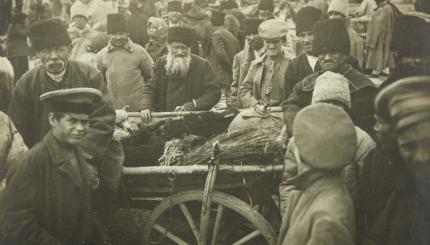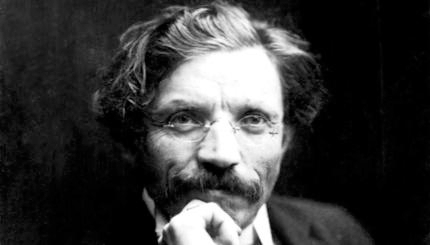Shalom Yakov Abramowitz is better known by the name of his most famous character, Mendele Mokher Seforim, which means “Mendele the Bookseller.” Abramowitz–along with the authors Sholom Aleichem and Isaac Leib Peretz–defined the classical age of Yiddish literature. Reprinted with permission from Meshuggenary: Celebrating the World of Yiddish (Simon & Schuster).
Mendele Mokher Seforim (1835-1917) is revered as the “grandfather of Yiddish literature” for his innovations in laying a new literary framework for Yiddish. His work realistically portrayed Jewish life with honesty and without judgment and depicted the world of the shtetl [village] with all its poverty and decay; all its joy and poetry. Mendele was born in Belorussia (Belarus) and came from a comfortable family of Lithuanian rabbis. He initially wrote in Hebrew and was a proponent of the Haskalah [Enlightenment].
 But as he wrote in his Complete Works: “I tried to compose a story in simple Hebrew, ground in the spirit and life of our people at the time. At that time, then, my thinking went along these lines: Observing how my people live, I want to write stories for them in our sacred tongue, yet most do not understand the language. They speak Yiddish. What good does the writer’s work and thought serve him, if they are of no use to his people? For whom was I working? The question gave me no peace but placed me in a dilemma.” (Quoted in The Oxford Book of Jewish Stories, edited by Ilan Stavans, New York: 1998.)
But as he wrote in his Complete Works: “I tried to compose a story in simple Hebrew, ground in the spirit and life of our people at the time. At that time, then, my thinking went along these lines: Observing how my people live, I want to write stories for them in our sacred tongue, yet most do not understand the language. They speak Yiddish. What good does the writer’s work and thought serve him, if they are of no use to his people? For whom was I working? The question gave me no peace but placed me in a dilemma.” (Quoted in The Oxford Book of Jewish Stories, edited by Ilan Stavans, New York: 1998.)
After spending 10 years writing in Hebrew, in the 1860s he began writing in Yiddish continuing for two decades. Mendele’s novels and stories from this period were for the Jewish masses and include: Dos Vintshfingerl (The Magic Ring), Dos Kleyne Mentshele (The Little Man), and Fishke der Krumer (Fishke the Lame). Mendele’s work ultimately challenged the Haskalah position that Jews needed to give up aspects of their identity in order to be accepted by Christian society. In Di Kliatshe (The Mare, 1873), a powerful satire, Mendele allegorically depicts the Jew as a despised beast of burden, suffering as the world’s scape goat. Yet this abused animal has dignity and a moral superiority that demands justice rather than mercy from its tormentors. The story is narrated by “Crazy Yisrulik” (Yisrulik dem meshugenem), who also tell the story “Di Byabak” (The Marmot), also written in 1873. In this tale Yisrulik is granted his wish and is transformed into a marmot, who the encounters and converses with the angel Gabriel. Yisrulik was the second narrative figure used by the writer after Mendele the Bookseller.

Help us keep Jewish knowledge accessible to millions of people around the world.
Your donation to My Jewish Learning fuels endless journeys of Jewish discovery. With your help, My Jewish Learning can continue to provide nonstop opportunities for learning, connection and growth.
Mendele’s work could be critical of Jewish patrician society and often placed him in conflict with community leaders. Two contrasting themes in his writing reflect his own ambivalence: satiric and/or critical treatment of the ghetto Jew afflicted by stagnation, ignorance, and isolation, contrasted by a sympathetic love and defense of his people. Mendel boldly opposed Russian anti-Semitism and Jewish persecution and often used symbolism and allegory to depict these conditions. Their works had a profound stylistic and thematic influence on Yiddish literature, examining Jewish life with criticism, satire, pathos, and humor.
Mendele’s work and life exemplify the broad spectrum of the historical and linguistic development of Jewish culture in the 19th century. His writing developed a new realism in fiction and nonfiction. He wrote in Hebrew and Yiddish, often emphasizing one language over the other for specific genres. He depicted the major cultural forces the Jew faced in entering the modern world: Haskalah and assimilation; the shtetl with its anti-Semitism and social oppression; Zionism with its call for Jewish nationalism.
Mendele’s legacy invited both praise and criticism. His depiction of East European Jews was acclaimed as a sober rendering of their often harsh lives, yet others felt he reinforced negative Jewish stereotypes. Mendele forged a new literary path, and created a modern portrait of an ancient people faced with ambivalence and contradictions on the threshold of a radically changing world.


